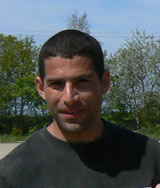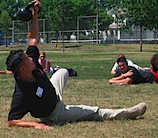Suleiman Al-Sabah: Yet Another Fit Researchin' Geek
One of the challenges of IAMGEEKFITters is figuring out how to combine good eating and physical activity with the more time consuming, cerebral demands of like in academia, where the main physical requirement is to work in front of a computer screen. So are there models of folks who are in similar situations who have, however, found a path to working on getting healthy
A few months ago IAMGEEKFIT profiled PhD student Mike T. Nelson to see what motivates him to get out of the lab, and go pick up stuff and put it down, many times, all within the demands of courses, classes, exams and numerous other pay-the-rent obligations.

Today, i'm pleased to be able to introduce another person in the Research space, Suleiman Al-Sabah. Besides already holding a PhD and working as a fulltime researcher at Reading, Al has serious chops in karate and is also an RKC kettlebell instructor. The following presents an interview with Al, covering his research, his background in wellness, and how he keeps motivated to go move his body rather than spend more time at the microsope.
Read on for the interview
When did you complete your PhD and what is your research area?
2003, University of Leeds. I would call the area molecular pharmacology. More specifically I investigated a specific receptor that is now targeted by a molecule found in lizard venom to treat diabetes (Exendin-4 – trade name Byetta). It was very much a structure/function study or ‘mutate and see’.
Why did the gila monster (the lizard) evolve to have a component in it’s venom that potentiates insulin secretion in a glucose dependant manner?
If you could point readers to one article about your field, what would it be?
Maudsley, S., Martin, B., and Luttrell, L. M. The origins of diversity and specificity in G protein-coupled receptor signaling. (2005) J Pharmacol Exp Ther 314(2), 485-494
…a nice review but doesn’t cover some of the newer concepts.
and this one for the technique I use the most;
Krasel, C., Bunemann, M., Lorenz, K., and Lohse, M. J.Beta-arrestin binding to the beta2-adrenergic receptor requires both receptor phosphorylation and receptor activation.(2005) J Biol Chem 280(10), 9528-9535
Is choosing two papers cheating?
You use what you need, sir. No worries.
What's the research question you're most interested in right now, and how come?
What comes first, activation of c-src or receptor phosphorylation? and if that is too cryptic or esoteric I am investigating the mechanism of receptor desensitization (or the loss of response to a drug over time) and if that can be harnessed therapeutically.
Neat. Ok, how can drug desensitization over time be used beneficially, if that's what you're saying you want to investigate?
OK I bit more background first.
Traditionally drugs can be classed as agonists; which activate a receptor, antagonists; which block the effect of an agonist and partial agonists; that do not achieve the same level of response of a full agonist.
It has been shown that some receptors can signal even in the absence of an agonist (be it the natural agonist or a drug). This is termed ‘constitutive activity’. Some drugs that were thought to antagonists are in fact ‘inverse agonists’; that is they reduce the activity of a constitutively active receptor. One consequence of treatment with an inverse agonist can be, in some cases, receptor up regulation; this is an increase in the number of the receptors at the cell surface making the cell more responsive to a given stimulus. This may be beneficial in some circumstances but it is not the desired effect if you had initially set out to block that receptor. Receptor desensitization may be a way to achieve a ‘super receptor blocker’ especially if the drug is ‘biased’ to arrestin-dependant signaling as opposed to classical G-protein dependant signaling. I am just speculating here but understanding the mechanism of desensitization will help in the development of therapies that are limited by this process.
Interestingly, it is thought that topical capsaicin (used to relieve pain in some conditions) acts by causing desensitization of the nerves involved in carrying the pain signal and a recent review has highlighted the capsaicin receptor (TRPV1) as a potential target in the treatment of diabetes (Suri & Szallasi 2007).
Wow. Very cool. To move from your research to help folks at the micro level to the physical stuff at the macro: you're an advanced level karate practitioner. When did you start your MA practice? Has it ever conflicted with school?
I started when I saw at school at about the age of 13. No, it never conflicted with school. I would say it taught me focus and discipline and if anything, helped me in my academic endeavours. I was never a naturally gifted athlete and as my instructor was also my physics (Ron Hicks now a 5th Dan black belt ) teacher I could intellectualise the training process.
How did you maintain your MA practice through your PhD work?
I found the two complemented each other well. You need tenacity at get anywhere in either. Although I worked hard in the lab I had plenty of time to train. Looking back now I think I was training too much, but it never had a negative impact on my work. I know many PhD students that spend too much time procrastinating, they end up working late as a result and I never found that I was very productive late in the evening. Blowing of some steam in the dojo was a better option.
Was karate your main physical activity or were there other things you did either in the gym or at home as part of a "work out"?
Initially.
I was one of the top ranking karateka at the university club and was encouraged by our instructor, the mighty Bob Rhodes to train at the city club where I found my self at the bottom of the ranking order. These guys pretty much made up the national team. I was getting thrown around like a rag doll and though I needed to do something to get stronger so I started weight training.
Of course this was really bodybuilding, which was not what I needed. It was about this time that I discovered the work of Pavel Tsatsouline. ‘Beyond Stretching’ really changed the way I trained as did ‘Power to the People’ and later ‘The Russian Kettlebell Chalenge’. I used to deadlift at lunch time at the university weight room which was 5 min from my lab and I got hold of a kettlebell from Stan Pike and started training with that. I even convinced the university sports center to buy a pair of kettlebells, I don’t think they would have agreed if they knew what they were.
Most folks who are working on their PhD's are obsessed with the degree, especially the dissertation: it's all encompassing and it becomes a great way to say no to things like working out or eating right because, heck there's just no time; other priorities, etc. So how you managed to keep up with your practice is of moment.
I think that you have to be obsessed with, or at least passionate about, your subject if you are going to pursue it to PhD level. In the life-sciences there is also the problem that there is often very little correlation between the amount of work you put in and the results you get, very frustrating.
I find the trick to staying active is to make it a habit, setting goals also helps.
That way training does not eat into my time I just make it part of my day and working at a university makes really easy.
I get up early do some joint mobility/dynamic stretching and some karate based drills, sometimes a little kb work. I walk past the university (Reading these days) gym on the way to work and some days do a few pull-up ladders. Takes very little time and I am still in work early and alert. Depending on work some lunchtimes (“Time is an illusion. Lunchtime doubly so.” Douglas Adams, Hitchhikers Guide to the Galaxy) I will walk to the gym on campus and do a bit of exercise (a couple of sets of deadlifts or some more pull-ups) this takes less time than most take for lunch.
Then when I get home in the evening I will finish off any kettlebell training I had scheduled. I don’t have to find an hour plus where I work out. Even when I trained for a half-marathon at the start of the year most of my sessions were just running home from work the long way.
That is so awesome: running to work as half marathon training. Were you able to keep up your nutrition, too? If so what was your practice?
Well I have experimented with all kinds of weird and wonderful nutritional programs. It is very easy to eat inappropriately in our environment – lots of easily available junk food. So I always strived to eat correctly. Again, like training, it is easier to stick to a program/diet if you make it a habit.
What has changed if anything in your health/fitness practice since moving to full time research?
I train much less. Maybe it is because I am older but I couldn't’t recover from what I used do. I haven’t done a formal karate session for several years. This is partly because of karate politics but also most sessions start at 8pm. I find that I am much too alert after training and it takes a good few hours to wind down. I need my sleep. I also try to focus on one goal at a time instead of chasing everything at once like I once did.
You're a certified kettlebell instructor. Where, when and how did kettlebells come into your life?
At Leeds when I was a PhD student, about 2000. Stan Pike was the only person I could get hold of one from back then. I still have one of his early models. Now they are everywhere (except at Reading University!). It was from reading Pavel’s work that got me interested. He used karate terms like kime in his writing, that really intrigued me. I think training with kettlebell improved my karate, they definitely improved my stamina, flexibility and posture.
What made you decide to certify?
I wanted to make sure I was training correctly. I had already decided that this was going to my main from of exercise for the foreseeable future and there is more to the RKC style of training than just lifting a round weight with a handle. It is the training system, not the training tool.
You may be interested to know that somebody I used to train with (karate) has now started his own kettlbell instructor’s certification (www.KettlebellSeminars.co.uk ). I have been training with kettlebells for as long as him. I wanted to make sure I was still learning and I am please to say that I learnt a lot at the RKC.
Have any of your colleagues picked up the KB habit from you?
Some did in Leeds. Not many of my colleagues in Reading have, although some friends have, my wife has. I think my colleagues see it as a weird macho thing not the incredibly time-efficient and effective all-round fitness tool that it is. I think they prefer their Wii fits. I want to drop a KB on a Wii fit.
i would like to see that on you tube. What council would you have for grad students/RA's who say either
- a.they don't have the time to work out
- b.don't need to work out
- c. don't really need to eat right?
A) You do have time. It doesn’t have to be hours straight. It can be few minutes spread through out the day. You are not working every waking hour are you? Lean to exercise effectively and efficiently and you will find the time easily.
B) Does your back hurt? What does your posture look like? If you sit at a desk or work in a lab all day you probably need to do some form of exercise, but that’s just my opinion. A good exercise program should enhance your life.
C) If you have made the decision to eat ‘right’ then you will find the time. Organize yourself so that eating ‘right’ is a habit. There is a lot of argument as to what ‘right’ is (e.g. vegetarians, high carb low carb etc). But ‘wrong’ is probably the highly processed stuff you get in packets. Do some research (It’s what you are good at), and make informed decisions.
Any other comments you'd like to add about either recommendations/tips for grad students thinking about starting a fitness/eating program?
I work in the health sciences, and I am surprised that other who do, don’t make exercise a priority in their life. The side-effects are great! We in the developed world have a struggle on our hands avoiding the diseases of our affluence. Making exercise and eating appropriately second nature seems like a sane approach.
Thanks for your time, Al. Great discussion.
 Some folks mistake strength for massive muscles, or take strength to be expressed as feats of strength, like tearing a phone book in half, or throwing a stone half way across a football field. But strength is our ability to contract our muscles to do work: to hold a pencil; to sit up; to roll over in bed. All of these movements represent the coordinated actions of muscles working together to support us moving against gravity in physical space.
Some folks mistake strength for massive muscles, or take strength to be expressed as feats of strength, like tearing a phone book in half, or throwing a stone half way across a football field. But strength is our ability to contract our muscles to do work: to hold a pencil; to sit up; to roll over in bed. All of these movements represent the coordinated actions of muscles working together to support us moving against gravity in physical space. strong"men" culture. From wherever it harkens, it is a seemingly unique move in that the practitioner moves from a completely prone position to a completely standing position, and then back down to prone. The movement is also done focusing on either side of the body, thus working balance and coordination as well as strength. Over the past few years, the TGU has become a staple particularly in the Kettlebell community (
strong"men" culture. From wherever it harkens, it is a seemingly unique move in that the practitioner moves from a completely prone position to a completely standing position, and then back down to prone. The movement is also done focusing on either side of the body, thus working balance and coordination as well as strength. Over the past few years, the TGU has become a staple particularly in the Kettlebell community (
